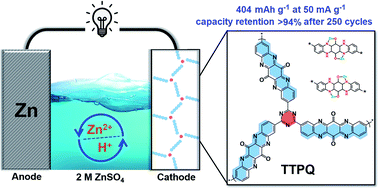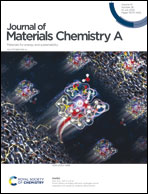A quinoxalinophenazinedione covalent triazine framework for boosted high-performance aqueous zinc-ion batteries†
Abstract
Featuring low cost, safety and environmental friendliness, aqueous zinc-ion batteries (AZIBs) have emerged as a promising grid-scale energy storage solution; however, they are facing challenges especially because of their moderate capacity and short cycling life. We herein develop a quinoxalinophenazinedione covalent triazine framework (CTF-TTPQ) knotted by triazine nodes as an organic cathode to boost the energy storage capacity and cycle stability of AZIBs. Experimental and ex situ characterization studies together with DFT calculations reveal the H+/Zn2+ co-insertion mechanism and the simultaneous bonding of Zn2+ with high-density carbonyl and imine redox active sites. TTPQ exhibits superior electrochemical performance to most reported organic cathodes for AZIBs. Benefiting from the multiple electroactive C![[double bond, length as m-dash]](https://www.rsc.org/images/entities/char_e001.gif) O and C
O and C![[double bond, length as m-dash]](https://www.rsc.org/images/entities/char_e001.gif) N redox sites for ion intercalation/deintercalation, TTPQ exhibits high energy density (404 mA h g−1 × 1.07 V = 432.28 W h kg−1) and excellent cycling stability (>94% capacity retention after 250 cycles at 0.5 A g−1). The understanding on structure design of redox polymer cathodes and the ion intercalation mechanism for excellent electrochemical performance provided by this study will surely promote the new development of AZIBs for practical applications.
N redox sites for ion intercalation/deintercalation, TTPQ exhibits high energy density (404 mA h g−1 × 1.07 V = 432.28 W h kg−1) and excellent cycling stability (>94% capacity retention after 250 cycles at 0.5 A g−1). The understanding on structure design of redox polymer cathodes and the ion intercalation mechanism for excellent electrochemical performance provided by this study will surely promote the new development of AZIBs for practical applications.



 Please wait while we load your content...
Please wait while we load your content...